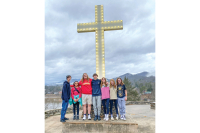Cherokee gathering casts light on generational trauma
When the microphone opened up to the crowd, Laura Stout felt compelled to say her piece. She raised her hand, got up from her front-row chair and walked to the podium where a dozen or more Cherokee people had spoken already.
They had talked about the tribulations they faced in their life, social ills that permeate the Cherokee reservation and stemming, in all likelihood, from the historical trauma of persecution and acts of genocide faced by their tribe two centuries ago.
Now, it was Stout’s turn, her turn to offload feelings that had weighed on her for most of her life. But for Stout, a white woman whose family has lived in North Carolina for 300 years, standing up before a mostly Cherokee crowd at this sacred Cherokee spot held a different significance. As Stout spoke about the burden of knowing what her ancestors did to the Cherokee and other peoples, it wasn’t long before she started to weep before the 100-person crowd gathered Saturday in a pavilion at Kituwah Mound, the birthplace of the Cherokee people not far from the present-day town of Cherokee.
But, now, she was finally able to stand before a gathering of Cherokee and ask for forgiveness on behalf of her family.
“It’s not enough to take it on. We have to do something about it,” Stout said.
Cherokee speakers talked about healing their own generational trauma that resulted partly from the Trail of Tears — healing that is possible only by forgiving people who brutally and forcibly drove the Cherokee from their land. Healing goes both ways, Stout said. When the Cherokee forgive white people for their wrongdoing, they are not the only ones who feel relief.
Related Items
“When the Native Americans forgive us, we heal,” Stout said.
Stout was one of more than a handful of white people who attended a universal gathering Saturday called “The Journey of Healing and Forgiveness.” It was an emotional day for many as they described personal strife and their efforts to move beyond them. The day was also a time for people to socialize, laugh and enjoy meals together.
The event as part of an effort by the Cherokee Healing and Wellness Coalition to start a discussion about the need to stop the downward spiral caused by generational trauma, or rather suffering that has passed down from one generation to the next.
The ramifications of the forced removal, known as the Trail of Tears, still impacts the Cherokee people today, said Patty Grant, a leader with the Cherokee Healing and Wellness Coalition. For generations, the lingering psychological impacts of that horrific time have been buried and repressed. But now, it is time to start talking about its effects and begin forgiving, she said.
The two-day event not only addressed long-term trauma caused by the Trail of Tears but also problems that are rampant on the reservation, such as alcoholism, drug abuse, diabetes and violence. The gathering was opened to everyone, not just those of Cherokee descent.
The side effects of trauma
The sunny and increasingly warm Saturday was the final day of a more than weeklong “Journey to Forgiveness and Healing.”
It began on May 18, when 26 members of the Eastern Band of Cherokee traveled to Tahlequah, Okla., where their brethren from the Cherokee Nation and the United Keetowah Band welcomed them with a traditional stomp dance. The participants then traversed the northern route of the Trail of Tears through Illinois, Tennessee, Kentucky, Missouri and Georgia, stopping at significant locations along the way. The travelers arrived back in Cherokee to conclude the event May 25 and 26.
The closing day Saturday started with a line of the attendees processing around Kituwah Mound behind a sacred hoop adorn eagle feathers that represents many things, including nature, the seasons and the circle of life.
The mound itself holds deep cultural and spiritual significance for the Cherokee because it is where the tribe began. The mound is tantamount to Jerusalem for Christians and Jews. People can actually visit locations talked about in Cherokee folklore.
“This is not where we come to. It’s where we come from,” Grant said.
Prior to the removal, “This was a peace place. There was no war. There was no conflict.”
In a speech later, Grant referred to removal as a prime example of generational trauma and said it is at least partially to blame for other ills in Cherokee society. Generational trauma is suffering that has passed down from one generation to the next. People are more likely to form an addiction if as a child their parents or caregivers suffered from such a problem, or become abusive if they themselves were abused.
The person becomes the thing they were harmed by, said Dr. Ann Bullock, the medical director of the health and medical division of the Eastern Band of the Cherokee Indians. Bullock was one of several scheduled speakers at the gathering.
It is biologically difficult to forgive someone or a group who has caused you harm because trauma affects a person’s ability to deal with a situation, particularly if it occurred at a young age, Bullock said. If something triggers a bad memory, stress hormones kick into high gear, and the person will mentally revert back to the age they were when the trauma occurred.
“Trauma in a sense freezes us,” Bullock said. “Needless to say, this does not put us at our best.”
When people experience a life-changing event or multiple traumatic events, they spend their life stressed and wondering when the other shoe will drop.
“We are always looking for the next wreck,” Bullock said.
Letting go
A number of people talked about how each new generation of Cherokee people had been taught to hate whites ever since the Trail of Tears in 1838. An idea that is by no means foreign, considering the many forms of racism that continue to persist the world over.
The Trail of Tears created distrust toward white people, particularly Andrew Jackson who is considered the greatest proponent of removing the Cherokee from their lands. The removal started a cycle of hatred that has lasted more than 150 years.
“(My mother) taught me to hate Andrew Jackson,” said Amy Walker, a speaker at the gathering. President Jackson ordered the removal via the Trail of Tears and is universally loathed by Cherokee people. Walker carried that same hate until four years ago when she decided to let go.
“Just before I found out that I had cancer, I decided that I was no longer going to allow a dead man to have that much of my life,” she said.
Walker, like most of the other speakers, deviated from the Trail of Tears and talked about personal tribulations that affected her life, including the death of her father at an early age and how the birth of a daughter was the result of rape.
During her journey to forgive, a trip that she is still on, Walker said she realized that she was taking out her anger toward her rapist on the daughter that resulted from it. She was unjustly laying blame on someone for something she did not do — a problem that is not contained to one person or ethnicity, Walker said.
Hugh Lambert, a member of the Eastern Band of Cherokee Indians and a speaker at the event, ran into many people who felt the same as Laura Stout when he participated in the Trail of Tears bicycle ride last year. Similar to the journey some of his fellow enrolled members took a week ago, the ride retraces the Trail of Tears and includes pit stops at culturally significant places. People would greet the riders and offer them food and drink.
“Everywhere we went it occurred to me that these people were saying, ‘We are sorry for what our ancestors did to your ancestors,’” Lambert said, calling the ride a powerful experience.
For Lambert, the ride was not only momentous because of the history of his people but also because of his personal history. Lambert was almost 300 pounds when he was diagnosed with Type II Diabetes in 2004. As an emotional eater with undiagnosed depression, he has always flirted with the border between pre-diabetic and diabetic. Until one day, he tumbled over that line.
But, for a year, he still did not change his eating habits or exercise. It wasn’t until he saw a documentary called “The Gift of Diabetes” about another native man struggling to control his diabetes and weight that Lambert realized he needed to shape up and stop making excuses.
The Cherokee need to forgive people for their wrongdoings and take responsibility for their problems as well, Lambert said in a speech to about 100 people this weekend.
“It is time as Indian people to stop being victims,” said Lambert, who now weighs less than 200 pounds.
What is the Trail of Tears?
In 1838, President Andrew Jackson pushed through legislation to remove the Cherokee Indians from their lands in Western North Carolina and other parts of the Southeast to Oklahoma so that white settlers could have their land.
White soldiers rounded up Cherokee people by force and placed them in fenced concentration camps while they continued to capture more Cherokee. Then, the Cherokee people were marched along one of five routes to Oklahoma where they were being forced to resettle.
Along the way to Oklahoma, thousands of Cherokee died from various maladies —malnutrition, exhaustion, disease, some froze to death along the Mississippi River during a particularly cold winter in Illinois. Those who survived the journey and made their home in the Oklahoma Reservation became known as the Cherokee Nation.
A small group who stayed behind became known as the Eastern Band. They fled and hid in the mountains from the white soldiers to escape the march to Oklahoma and were eventually permitted to stay.









